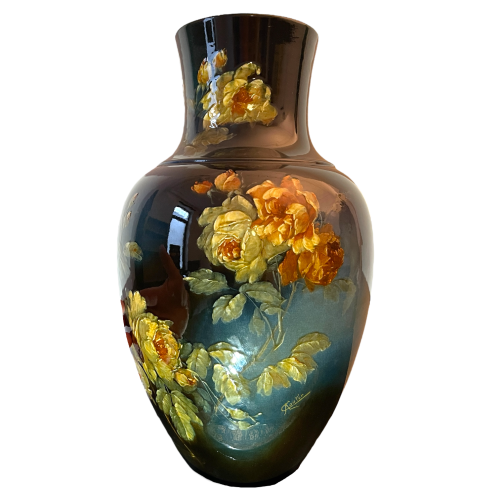A large Art Nouveau impressionist slipware ceramic vase with floral decoration of roses, foliage and rosebuds, circa 1900.
Signed in the decoration and numbered under the base (see images).
Very good condition, note the 3 marks under the base corresponding to the tripod firing supports in the kilns (see images, red arrows).
This vase is attributed to the Choisy-le-Roi factory, although it is also plausible that it came from Montigny-sur-Loing or the famous American factory Rookwood Pottery.
- Issuer / Manufacturer:CHOISY-LE-ROI.
- Period:19th century - End of 19th / 20th century / ca 1900.
- Country of Origin:France.
- Dimensions (H x W x D):52 x 30 x 30.
- Weight:4 Kg.
- Condition:Excellent.
- Style:Art Nouveau / Impressionist.
- Material:Ceramic / Earthenware.
-
Price:SOLD
The stylistic and technical elements of the piece reflect characteristics specific to these workshops, which were active in the late 19th and early 20th centuries. Choisy-le-Roi, known for its mix of utilitarian and artistic production, stands out for its meticulous decoration, polychrome enamels and motifs often influenced by Art Nouveau. Montigny-sur-Loing, on the other hand, is rooted in the naturalist movement inspired by the École de Barbizon, and produces pieces with pictorial decoration, depicting landscapes, flowers or rural scenes, usually hand-painted.
Rookwood Pottery, an American manufacturer founded in 1880, is renowned for its innovative glazes, such as satin and flamed glazes, and its designs, which are often inspired by naturalism or Art Nouveau. Its pieces have an exceptional finish that could also match the qualities seen on this vase.
Precise attribution remains difficult, but the quality and aesthetics of this vase make it representative of these great ceramic houses.
The Choisy-le-Roi ceramics factory, founded in 1804 by Laurent Moyne, was one of the most important French earthenware manufacturers of the 19th and early 20th centuries. Under the management of Hippolyte Boulenger from 1863 onwards, it enjoyed remarkable growth and became a major player in the production of utilitarian and decorative ceramics in France.
Around 1900, at the height of its activity, the factory fully embraced the trends of Art Nouveau, an artistic movement characterised by naturalistic motifs, sinuous lines and a quest for harmony between art and craft. Choisy-le-Roi's creations from this period reflect this aesthetic, with decorations inspired by flora and fauna, and stylised female figures. The polychrome enamels, often rich and nuanced, and the transfer techniques mastered by the workshop made it possible to produce pieces that were both artistic and accessible.
The link between the Choisy-le-Roi factory and Montigny-sur-Loing lies in the tradition of artistic ceramics in France, but they are two distinct entities that developed at the same time and in a similar context.
The Montigny-sur-Loing faience factory, founded in the mid-nineteenth century, specialised in decorative ceramics, often hand-painted. The factory was an extension of the Barbizon School, an artistic movement inspired by nature and the landscapes of the Fontainebleau forest. Montigny-sur-Loing's work, influenced by this movement, is characterised by naturalistic designs depicting rural scenes, flowers, birds and romantic landscapes. These pieces were often made on fine earthenware bases, with translucent glazes that enhanced the pictorial effect.
In contrast, the Choisy-le-Roi factory, although known for its elaborate decorations, was more industrial in its production. Around 1900, Choisy-le-Roi diversified with Art Nouveau motifs, while Montigny-sur-Loing remained anchored in a more bucolic and pictorial style.
Today, Choisy-le-Roi ceramics remain highly sought-after by enthusiasts, bearing witness to an era when earthenware combined functionality with artistic refinement.
Packing and delivery costs to be expected:
Collection: Free.
For Belgium: 30€.
For France: 70€.
For Europe: 100€.
For the rest of the world: 200€.
